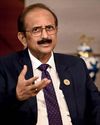
ROW AFTER ROW of racks stacked with computer hardware like servers and data storage devices packed into a large, air-conditioned hall. These data centres are the organs that run the networks that power everything from sending a WhatsApp message to initiating online payments to streaming sports matches. They store, process, and manage large amounts of data.
And they’ve seen massive interest in recent years because of the breakneck speed of technological advances, particularly Generative artificial intelligence (Gen AI), which requires much higher amounts of computational power. That has sparked a global race to build more data centres. And in India, too, data centres are being built at a frenetic pace.
“The average size of the data centres increased from the 20–30 MW range to 50–100 MW. And data centres that are able to support the high power requirement of AI are being built now,” says Vivek Dahiya, Managing Director and Head of the Data Centre Advisory Team, Asia Pacific at Cushman & Wakefield, the global commercial real estate services firm. He adds that the demand for data centres will double globally, driven by AI.
But there’s a catch here. These data centres consume massive amounts of electricity.
Data from the International Energy Agency (IEA) bears this out. In 2022, data centres consumed 460 terawatt hours (TWh) of electricity, or 2% of all global electricity usage. That is expected to double now, thanks to the increasing adoption of large language models (LLMs) for AI. The result is a likely increase in emissions from data centres that contribute around 2.5–3.7% of all global emissions, according to carbon intelligence start-up Climatic.
This story is from the {{IssueName}} edition of {{MagazineName}}.
Start your 7-day Magzter GOLD free trial to access thousands of curated premium stories, and 9,000+ magazines and newspapers.
Already a subscriber ? Sign In
This story is from the {{IssueName}} edition of {{MagazineName}}.
Start your 7-day Magzter GOLD free trial to access thousands of curated premium stories, and 9,000+ magazines and newspapers.
Already a subscriber? Sign In

BUILDING TOMORROW'S CARE TODAY
The Indian pharma industry is at a juncture where digital transformation is sweeping the healthcare landscape

BIG SHOTS
GIVEN THAT MORE THAN 40% OF INDIAN ADULTS ARE STRUGGLING WITH OBESITY AND DIABETES, AFFORDABLE WEIGHT-LOSS DRUGS ARE EXPECTED TO SIGNIFICANTLY DISRUPT THE PHARMACEUTICAL LANDSCAPE IN THE COUNTRY THIS YEAR. AND, THE WEIGHT MANAGEMENT MARKET COULD REACH ₹3.99 LAKH CRORE BY 2032, GROWING AT A CAGR OF MORE THAN 9%

THE END OF AMERICAN FINANCIAL EXCEPTIONALISM
As the dollar cycle reverses and Asia's rise continues, Indian growth will accelerate

HOW TO ADAPT TO EXTREME HEAT
India is vulnerable to extreme heat and yet unprepared. But various initiatives provide a glimpse of what is possible when collaboration and ingenuity come together

THE WORLD IN 2030
The policy implications are that India would have to maintain a strong link to a re-industrialising US but find a way to use Chinese capital and inputs

A PEEK INTO THE FUTURE
INDIA IN 2025 AND BEYOND: TRENDS TO WATCH OUT FOR

"STEERING SBI INTO THE FUTURE"
C.S. Setty, Chairman of the State Bank of India, talks about his plans for the bank, the strategy for the future, and technology, among other things

"Outlook for India is very positive"
Paul Uren, Head of Investment Banking (Asia-Pacific), J. P. Morgan, on M&A activity, the environment of investment banking market in India, and more

The 2025 Slate
The Indian film industry is hoping that 2025 will mark the return of big-budget blockbusters

TECH, SET, GO!
With up to 30 tech start-ups looking to go public, the year promises to be a turning point for India's thriving start-up ecosystem